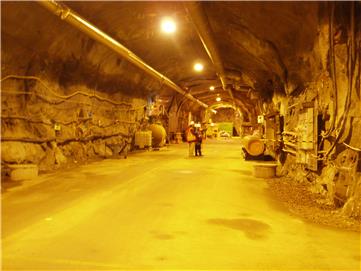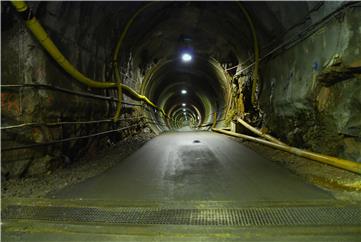Radioactive Waste Disposal
Contributed by Richard Shaw, Principle Researcher in Radioactive Waste with the British Geological Survey
Background

One of the experimental galleries at a depth
of 420m in SKB’s
underground research laboratory
at Aspo, Sweden. Rob Cuss © NERC 2008
The United Kingdom has been operating commercial nuclear reactors since 1956 with up to 28% of our electricity being generated in nuclear power stations over this period. This proportion has now dropped to about 19% because the older nuclear power stations have reached or are approaching the end of their working lives. All but one of those still operating will be retired by 2023. With international concerns about carbon dioxide emissions and their effect on global climate many countries, including the UK, are now seriously considering building new nuclear power stations as part of their portfolio of energy sources. While nuclear power provides electricity with a very low CO2 emission it does create radioactive waste. The quantity of radioactive waste produced at nuclear power stations is relatively small when compared to the quantities of ash and other wastes that coal fired power stations produce for example. Many countries also believe that energy should be provided by a portfolio of sources with no undue reliance on any one type of power generation and that nuclear power has an important role in their energy strategies. Whether or not we build new nuclear power stations, we have a legacy of radioactive waste from over 50 years of commercial exploitation of nuclear power for which a safe, long term means of disposal is required. Groundwater is an important consideration for the disposal of nuclear material both during the construction of waste repositories and for long-term waste storage.
Disposal of radioactive waste
In the UK there have been a number of attempts to find a solution for the disposal of radioactive waste. Several possible options were investigated between 1959 and 1975 including the potential to use existing mine workings etc but none of these were pursued. Since the mid-1970s there have been two major programmes in the UK to systematically select site(s) for geological disposal of radioactive waste. Mather (1997) provides a useful review of these programmes. The first of these programmes commenced in the mid 1970s and focused on finding a site for the disposal of high level radioactive waste but was cancelled by Government in 1981. The second one was led by Nirex during the 1980s. This programme focused on finding a site for the disposal of intermediate and long lived low level radioactive wastes and looked at a number of shallow and deep disposal options culminating in the investigation of sites at Sellafield and Dounreay for deep disposal. However, this programme stalled in 1997 when approval to construct an underground research laboratory at Sellafield was declined by the Secretary of State following a Public Inquiry.
The Committee on Radioactive Waste Management (CoRWM) was set up in 2003 by the Government, under their Managing Radioactive Waste Safety (MRWS) programme to examine all the potential options for the safe management of the United Kingdom’s radioactive waste. In the summer of 2006 CoRWM recommended to Government that deep geological disposal is currently the best means available of managing our radioactive waste. They recognised that the development of a repository would take several decades. Consequently a supplementary recommendation for a period of secure, interim surface storage was made while a site, or sites, were identified, their suitability confirmed by a detailed geological investigation, and the construction of the facility completed. They also recommended that the process of selecting a site should be based on community ‘voluntarism’. The Government accepted these recommendations in October 2006.
Criteria for deep geological disposal of radioactive waste
Many earth scientists think that deep geological disposal of radioactive waste in a suitable geological environment is the best means of disposing of these wastes. Chapman and Curtis provide an overview of this confidence.
In 2007, under their MRWS programme, the Government launched a consultation on how these recommendations could be realised. This included a series of geological criteria which could be applied equally to all volunteer communities so that any areas clearly geologically unsuitable for disposal of radioactive waste could be eliminated at an early stage in the process. These ‘exclusion criteria’ were established by a group of geoscientists appointed by Government on the basis of recommendations from a number of organisations including the Royal Society and the Geological Society. Their suggested criteria were reviewed by an international panel of experts. The main factors that would make an area unsuitable are:
- Presence of deep (greater than 100m) coal resources;
-
Presence of known hydrocarbon (oil or gas) resources;
-
Presence of known oil shale resources;
-
Past exploitation of or known metallic ores;
-
Development within an aquifer;
-
Presence of or committed development of a deep waste disposal or gas storage facility.

Tunnel boring machine driven incline from the 420m to 440m levels
in SKB’s underground research laboratory at Aspo, Sweden. The
laboratory is constructed in granodiorite. Rob Cuss © NERC 2008
Following the period of consultation the Government prepared the MRWS White Paper ‘A Framework for Implementing Geological Disposal’, which was published in June 2008. This sets out the process of volunteering to host a facility, the initial screening and then the subsequent activities towards development. At the same time as publication of the White Paper a call for volunteer communities to express an interest in participating was made which is still open.
The MRWS White Paper specifies that, following a community’s expression of interest to participate, the British Geological Survey will apply the screening criteria for the area under consideration to identify what, if any, part(s) of it are excluded on the agreed geological factors. This process will be consistently undertaken for all volunteers utilizing readily available data. It will not be a review of all geological information about the area and will not entail any new data acquisition or interpretation. All volunteered areas that are not excluded by this screening will go forward to a much more detailed desk based study of all the geological information that is available for the area. This later process will be managed by the Nuclear Decommissioning Authority. They will provide reports on each area volunteered that will then be considered by the Government in drawing up a shortlist of sites for further, detailed investigation and characterisation. This will include drilling new boreholes and the acquisition of new geo-scientific data through a range of geological and geophysical surveys. The current schedule is for first waste emplacement in about 30 years.
All stages in the process will be open to scrutiny by stakeholders, including oversight by CoRWM. The Nirex repository project that ended in 1997 was only considering intermediate level waste (ILW) and some longer lived low level waste (LLW) but the MRWS programme is including not only the long-lived LLW and ILW but also high level waste (HLW). It is also considered that some spent nuclear fuel, plutonium and uranium may also be declared waste and that options for their disposal should also be included in repository design.
Geological options for deep disposal of radioactive waste in the UK
The United Kingdom has a diverse geological history and as a result there are many geological options for the deep geological disposal of radioactive waste. One of the key properties for a host rock is that groundwater flows in the vicinity of the facility are low. A number of geological environments found in the UK offer the potential for development of a repository. These include:

Driving a new experimental gallery at a depth of 490m in the Bure underground
research laboratory in the eastern Paris Basin, France. John Powell © NERC 2009
- ‘Hard’ rocks (e.g. igneous and metamorphic rocks) with low groundwater flow (such as in low lying areas or at depth below upland areas);
-
‘Hard’ rocks under a sedimentary cover, as was the case at both the Sellafield and Dounreay sites examined during the 1990s;
-
Thick mudrock sequences;
-
Salt (evaporite) deposits;
-
Dense brines in sedimentary basins;
A significant proportion of the UK’s geology is represented by these environments and offers potential for the development of a repository.
A deep repository is regarded as being at depths between 200 and 1000 metres. The maximum practical depth is dependent on the geological environment as are the details of the design, such a gallery dimensions. Current waste volumes, approximately 400,000 m3 (enough to fill Wembley Stadium about 3 ½ times) would require a ‘foot print’ area of around 4 km2 for a repository once factors such as heat generation have been taken into consideration. This does not necessarily mean that the surface area under which the facility is situated will be of this extent because there may be options to develop a facility on more than one level, such as a ‘multi-storey car park’ style that will reduce the surface area under which a repository is sited.
Deep geological radioactive waste disposal in other European Countries
While progress towards a solution for the long-term management of the United Kingdom’s radioactive waste has been progressing over the last 8 years, internationally some projects are now at an advanced stage. In Europe, Finland is developing an underground characterisation facility at Olkiluoto, known as the ONKALO, which has now reached a depth of about 320m. If ONKALO confirms that the site meets all the safety case criteria for the development of a repository, a facility will be developed at the site with a planned commencement of disposal operations around 2020. Sweden has evaluated two potential sites for the disposal of spent fuel, one near Forsmark and the other near Oskarshamn, and in June 2009 announced that their preferred site for the development of a repository was that at Forsmark. They also have constructed and operate the Äspö underground hard rock laboratory, near Oskarshamn, that is used for full scale in-situ testing of different technical solutions in a realistic repository environment and have operated an ILW disposal facility at Forsmark for 20 years. Both Belgium and France have underground research laboratories and are close to deciding where their disposal facilities will be located. All of these countries have worked in partnership with the local communities and have a high level of support from them for their projects.
Further Reading
Mather, JD, 1997. The history of research into radioactive waste disposal in the UK and the selection of a site for detailed investigation. Environmental Policy & Practice, 6, 4, 167-177.
The Geology and Hydrogeology of the Sellafield Area, Quarterly Journal of Engineering Geology and Hydrogeology, May 1996, Vol. 29, Is. Supplement 1.
Links

Print this Page